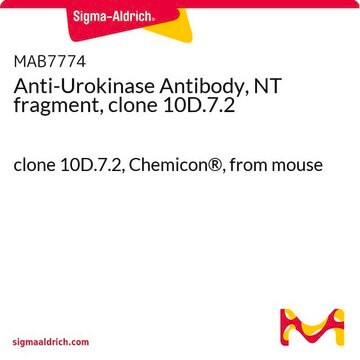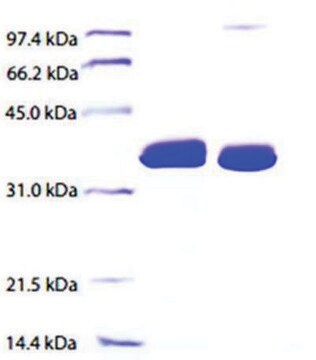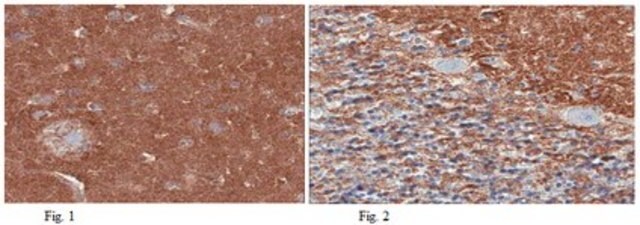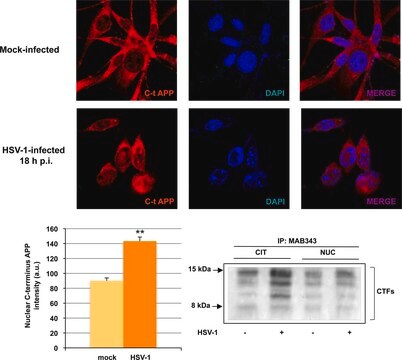ABN1350
Anti-ApoE4 Fragment nApoECF Antibody (Asp172)
from rabbit, purified by affinity chromatography
Sinónimos:
Apolipoprotein E, ApoE4 Fragment nApoECF (Asp172), Apo-E
About This Item
Productos recomendados
origen biológico
rabbit
Nivel de calidad
forma del anticuerpo
affinity isolated antibody
tipo de anticuerpo
primary antibodies
clon
polyclonal
purificado por
affinity chromatography
reactividad de especies
human
reactividad de especies (predicha por homología)
bovine (based on 100% sequence homology)
técnicas
immunofluorescence: suitable
immunohistochemistry: suitable (paraffin)
western blot: suitable
Nº de acceso NCBI
Nº de acceso UniProt
Condiciones de envío
wet ice
modificación del objetivo postraduccional
unmodified
Información sobre el gen
human ... APOE(348)
Descripción general
Especificidad
Inmunógeno
Aplicación
Western Blotting Analysis: 1.0 µg/mL from a representative lot detected ApoE4 fragment nApoECF (Asp172) in 10 µg of human Alzheimer′s diseased brain tissue lysate.
Immunofluorescence Analysis: A representative lot detected a strong nApoECF (n-terminal ApoE4 Cleavage Fragment) immunoreactivity co-localized with that of PHF-1 within Pick bodies of area CA1 by dual-fluorescent immunohistochemistry using free-floating hippocampus tissue sections from a Pick′s disease patient (Rohn, T.T., et al. (2013). PLoS One. 8(12):e80180).
Immunofluorescence Analysis: A representative lot detected nApoECF (n-terminal ApoE4 Cleavage Fragment) immunoreactivity co-localized with that of cleaved Tau (Asp421; Cat. No. 36-017) within Pick bodies of area CA1 by dual-fluorescent immunohistochemistry using free-floating hippocampus tissue sections from a Pick′s disease patient (Rohn, T.T., et al. (2013). PLoS One. 8(12):e80180).
Immunofluorescence Analysis:A representative lot detected the the nApoECF (n-terminal ApoE4 Cleavage Fragment) immunoreactivity co-localized with the PHF-1-positive neurofibrillary tangles (NFTs) in the frontal cortex of Alzheimer′s diseased brains by dual-fluorescent immunohistochemistry using formic acid-treated free-floating sections (Rohn, T.T., et al. (2012). Brain Res. 1475:106-115).
Immunohistochemistry Analysis: A representative lot detected a strong nApoECF (n-terminal ApoE4 Cleavage Fragment) immunoreactivity within Pick bodies of area CA1 among 4 out of 5 Pick′s disease patients-derived free-floating hippocampus specimens (Rohn, T.T., et al. (2013). PLoS One. 8(12):e80180).
Immunohistochemistry Analysis: A representative lot detected the specific association of the nApoECF (n-terminal ApoE4 Cleavage Fragment) immunoreactivity with the neurofibrillary tangles (NFTs), but not within the Abeta-positive senile plaques, in the frontal cortex of Alzheimer′s diseased brains using formic acid-treated free-floating sections (Rohn, T.T., et al. (2012). Brain Res. 1475:106-115).
Western Blotting Analysis: A representative lot detected the 18 kDa nApoECF (n-terminal ApoE4 Cleavage Fragment; a.a. 1-172) present in the preparations of bacterially expressed human ApoE4, but not the full-length ApoE4 itself or the caspse-3-cleaved 16 kDa ApoE4 fragment (Rohn, T.T., et al. (2012). Brain Res. 1475:106-115).
Note: This antibody will detect any ApoE fragments with Asp172 at the C-terminus. This antibody was raised against a hydrophobic immunogen sequence and therefore exhibits high affinity toward hydrophobic membrane surface. Multiple banding pattern and overall high background are expected when using this antibody for Western blotting applications, especially when employing tissue samples.
Neuroscience
Neurodegenerative Diseases
Calidad
Immunohistochemistry Analysis: A 1:250 dilution of this antibody detected ApoE4 fragment nApoECF (Asp172) in Alzheimer′s diseased human brain tissue.
Descripción de destino
Forma física
Almacenamiento y estabilidad
Otras notas
Cláusula de descargo de responsabilidad
¿No encuentra el producto adecuado?
Pruebe nuestro Herramienta de selección de productos.
Código de clase de almacenamiento
12 - Non Combustible Liquids
Clase de riesgo para el agua (WGK)
WGK 1
Punto de inflamabilidad (°F)
Not applicable
Punto de inflamabilidad (°C)
Not applicable
Certificados de análisis (COA)
Busque Certificados de análisis (COA) introduciendo el número de lote del producto. Los números de lote se encuentran en la etiqueta del producto después de las palabras «Lot» o «Batch»
¿Ya tiene este producto?
Encuentre la documentación para los productos que ha comprado recientemente en la Biblioteca de documentos.
Nuestro equipo de científicos tiene experiencia en todas las áreas de investigación: Ciencias de la vida, Ciencia de los materiales, Síntesis química, Cromatografía, Analítica y muchas otras.
Póngase en contacto con el Servicio técnico








